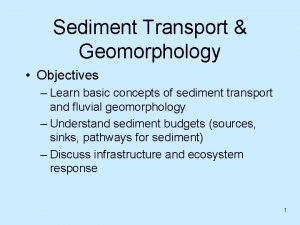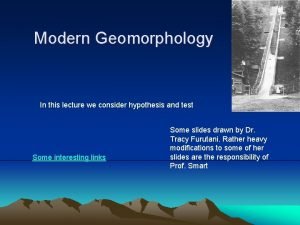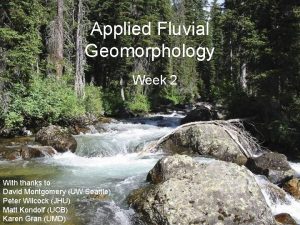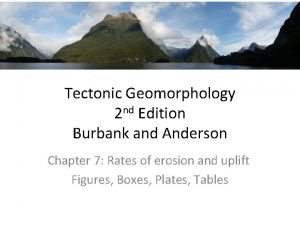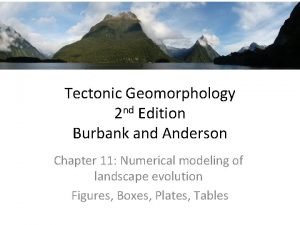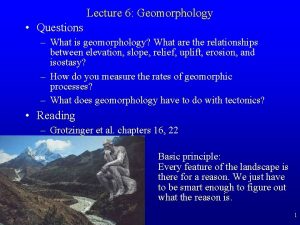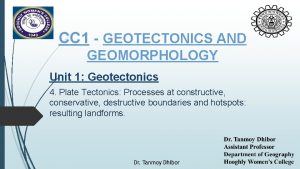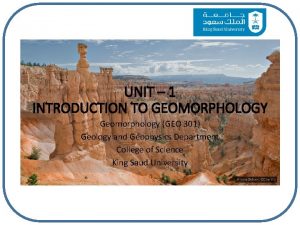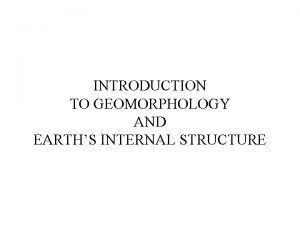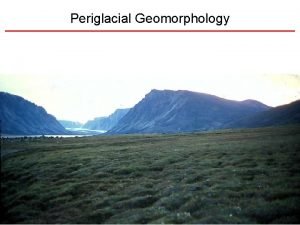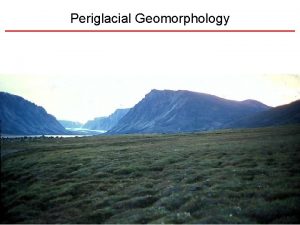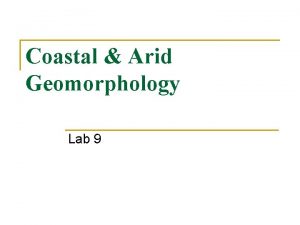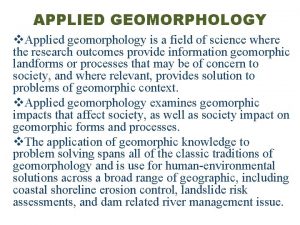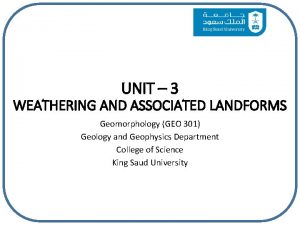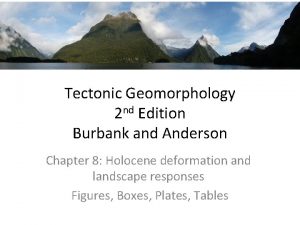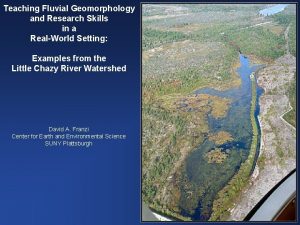CC 1 GEOTECTONICS AND GEOMORPHOLOGY Unit 2 Geomorphology

















- Slides: 17

CC 1 - GEOTECTONICS AND GEOMORPHOLOGY Unit 2: Geomorphology 6. Karst landforms: Surface and sub-surface.

KARST LANDFORMS : Karst is a term used to describe landscapes that are formed by chemical weathering process controlled by groundwater activity. Karst landscapes are predominantly composed of limestone rock that contains > 70 percent calcium carbonate. • Word is German form of the Yugoslavian term “ Kras ” means “bare stony ground” • Named after investigating a region near the Adriatic Sea in Yugoslavia • In modern Geomorphology the term refers to any landscape formed by dissolution of the underlying bedrock • Characterized by distinctive landforms which don’t typically occur in any other circumstance

MAJOR KNOWN KARST REGIONS OF THE WORLD

FACTORS AFFECTING KARST PROCESSES: Solubility of Bedrock - percent calcite Climate - Temperature and Moisture Structure of Limestone - joints, fractures, porosity, Vegetation/Non-carbonate Geology - acidity (p. H) of groundwater Atmospheric CO 2 - affects solubility of Carbonates Pseudokarst: is the term for karst-like development in non-carbonate lithology that exhibits characteristics similar to karst landscapes, but which lack dissolution as a primary means of landscape formation.

ADDITIONAL CONSIDERATION: WATER TABLE: Rocks are dissolved by water: surface water or groundwater. �Carbonates, limestone (Ca. CO 3), and dolostone (Ca. Mg(CO 3)2)are dissolved by acidic water. �Evaporites, rock salt, and gypsum (Ca. SO 4. 2 H 2 O) are dissolved by water.

CHEMICAL WEATHERING: CARBONATION �Carbonation is a process by which carbon dioxide and water chemically react to produce carbonic acid, a weak acid, that reacts with carbonate minerals in the rock. �This process simultaneously weakens the rock and removes the chemically weathered materials. CO 2 + H 2 O air H 2 CO 3 water Ca. CO 3 carbonic acid + H 2 CO 3 calcium carbonate carbonic acid Influenced by: Temperature Pressure Partial pressure of CO 2 p. H Ion concentration Ca++ calcium ion + 2 HCO- 3 bicarbonate ion

Surface Landforms: Limestone Pavement Exposed areas of limestone Rugged and bare landscape with flat areas of rock surface Gradual widening of joints and fractures (bedding)

Surface Landforms: SINKHOLES: Groundwater dissolves soluble rock, creating fractures and caves. Dissolving continues to form larger caves and fractures. Dolines (Sinkholes, Cenotes): Collapse sinkholes form when water level drops. Solution sinkholes due dissolution at surface.

Surface Landforms: Sinkholes �Occur in a range of sizes, and can be temporarily, seasonally, or permanently filled with water. �Sinkholes pose a threat to developed areas. �Increased pressure on water resources and depleted ground water tables can trigger sinkholes to collapse under the pressure of gravity or the void formed by the depleted ground water.

Types of Sinkholes : �Solution Sinkhole Little or no sediment is present over limestone Easily dissolved by water �Cover-Subsidence Sinkhole Thick sediments overlay limestone Underlying limestone is dissolved, sediments dump into the void �Cover-Collapse Sinkhole Triggered by heavy rainfall, drought, overloading Cause sudden collapse into void Uvala: series of smaller sinkholes coalesce into a compound sinkhole.

Disappearing Streams: �Streams that flow on the surface and then seemingly “disappear” below ground. �Disappearing streams disappear into a sinkhole or other karst solution features (caves) �They may also disappear into factures or faults in the bedrock near the stream. �Disappearing streams are also referred to as losing streams, sinks, or sieves.

Springs : Karst springs are locations where groundwater emerges from the limestone and flows across the surface forming a stream or contained pool. The flow of Karst springs is generally dependent on the weather and climate. Ephemeral springs only flow following rainfall or snowmelt events. More permanent springs are connected to aquifers and flow year-round.

Karst Towers: �Landscape is mottled with a maze of steep, isolated limestone hills �Limestone beds are thick and highly jointed �Puerto Rico, western Cuba, southern China, and northern Vietnam �CO 2 production by vegetation in these climates facilitates weathering TOWER KARST OF PENINSULAR THAILAND SOUTH CHINA KARST TOWER

Subsurface Karst Features: Caverns �Limestone caverns and caves are large sub-surface voids where the rocks has been dissolved by carbonation. �In sections where the ground water table has dropped, pressure release promotes precipitation of minerals creating a variety of speleothems

Caverns : �Calcium carbonate precipitates out of the saturated carbonate solution and accumulates as deposits. �Stalactites are deposits that grow from the ceiling downward �Stalagmites are deposits that grow from the ground up. �If the stalactite and stalagmites join they form a continuous column. �Mammoth Cave in Kentucky and Carlsbad Caverns in New Mexico are two of the largest cave systems in North America.

Soda straws to stalactites �Soda straws are initially hollow, allowing dissolved limestone to travel through the tube. �Because a dissolved solid is traveling through the tube, it sometimes gets plugged up. �This forces the dissolved limestone to “back up” and start flowing on the outside of the straw. �Eventually, it thickens and becomes recognizable as a stalactite!

Additional Fun Karst Features Abime, a vertical shaft in karst that may be very deep and usually opens into a network of subterranean passages. Cenote, a deep sinkhole, characteristic of Mexico, resulting from collapse of limestone bedrock that exposes groundwater underneath. Foibe, an inverted funnel-shaped sinkhole Scowle, porous irregular karstic landscape in a region of England. Turlough (turlach), a type of disappearing lake characteristic of Irish karst Uvala, a collection of multiple smaller individual sinkholes that coalesce into a compound sinkhole. Word derives from South Slavic languages. Karren, bands of bare limestone forming a surface Limestone pavement, a landform consisting of a flat, incised surface of exposed limestone that resembles an artificial pavement Polje (karst polje, karst field), a large flat specifically karstic plain. The name "polje" derives from South Slavic languages. Doline, also sink or sinkhole, is a closed depression draining underground in karst areas. The name "doline" comes from dolina , meaning "valley", and derives from South Slavic languages. Karst spring, a spring emerging from karst, originating a flow of water on the surface Ponor, also sink or sinkhole, where surface flow enters an underground system. Derived from South Slavic languages Sinking river, or ponornica in South Slavic languages Karst fenster ("karst window"), a feature where a spring emerges briefly, with the water discharge then abruptly disappearing into a nearby sinkhole
 Applied geomorphology notes
Applied geomorphology notes Objectives of geomorphology
Objectives of geomorphology Geomorphology hypothesis
Geomorphology hypothesis Applied fluvial geomorphology
Applied fluvial geomorphology Geomorphology
Geomorphology Dynamic equilibrium in geomorphology
Dynamic equilibrium in geomorphology Geomorphology
Geomorphology Forces
Forces Application of geomorphology
Application of geomorphology Unit 6 review questions
Unit 6 review questions Hyp opp adj
Hyp opp adj Unit process and unit operation
Unit process and unit operation Difference between unit process and unit operation
Difference between unit process and unit operation Surplus keuangan adalah
Surplus keuangan adalah Si vs english units
Si vs english units Unit test review algebra 2
Unit test review algebra 2 Contoh kebutuhan mengitung unit cos unit kerja rekam medis
Contoh kebutuhan mengitung unit cos unit kerja rekam medis Setiap unit akuntansi dianggap sebagai unit yang mandiri
Setiap unit akuntansi dianggap sebagai unit yang mandiri

